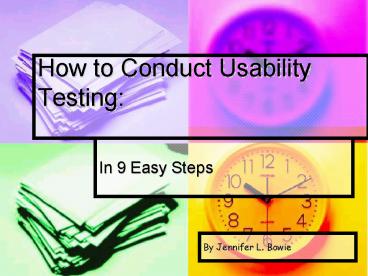How to Conduct Usability Testing: PowerPoint PPT Presentation
1 / 12
Title: How to Conduct Usability Testing:
1
How to Conduct Usability Testing
- In 9 Easy Steps
By Jennifer L. Bowie
2
What is Usability?
- A function of particular users performing
particular tasks in a particular environment
(Smith et al. 68) - The people who use the product can do so quickly
and easily to accomplish their own tasks (Dumas
and Redish 4) - User-centered design, not user-friendly
3
What is Usability Testing?
- An empirical study of a products usability by
observing actual users do real tasks with the
product - Involves
- Real users
- Real tasks
- Specific usability goals/concerns
- Observing and recording the testing
- Data analysis
4
Step 1 Analyze your Actual Users Choose
Profiles
- Who are your actual users? You may need to break
your users into typical user categories.
Consider - Demographics of your users (age, sex, race,
education level, cultural background,
socioeconomic status,)? Will these differences
impact use? - Experience level (with the product, with products
of the same genre, with required technology,...)? - Other things motivation, learning style, subject
matter knowledge, location of use, physical
characteristics, people with disabilities or
impairments (from color blindness and learning
disabilities to more severe disabilities),
5
Step 1 Analyze your Actual Users Choose
Profiles con.
- Create user profiles
- Break users into clear subgroups
- Profile/Define the characteristics of each
subgroup - Choose user profiles to test
- Ideally users from all major profiles will be
tested - If limited testing Choose profiles based on
highest number of users in that profile or
profiles that you think may have the greatest
usability issues
6
Step 2 Select Test Points
- What is your objective? What test points get you
there? - Test Task/Procedure- look for tasks with a high
chance or high cost of user failure - Test Terminology- consider level of user
- Test your document design strategies- consider
cueing patterns, heading/layout, navigation,
extraordinary features, how text and visuals
relate...
7
Step 3 Choose Type of Test
- Task (can-they-do-it) Requires users to perform
a procedure - Terminology (can-they-understand-it) Requires
users to provide a summary of what they have read
or definitions of key terms - Document Design (can-they-find-it) Requires
users to use mocked-up portions of the manual to
find information on key topics
8
Step 4 Set Performance Objectives
- Consider how you will come up with your data
- Time related time taken to perform procedure or
find a topic - Error related number of errors made during a
procedure, number of time passage re-read, number
of tries - Objectives should be task individualized
9
Step 5 Select your Users
- Actual users always best
- Similar users not as best, may have to find ways
to make them more even with a actual testers
(give them more information, have them pretend
they know less) - Non-Similar users very different and the worse
types. May have to do a lot of work to make them
more appropriate
10
Step 6 Create Test Plan
- Create a written plan for the testing
- Choose order of tasks start easy
- Create written test materials
- Task list for users
- Written welcome speech/Intro to be read to user
- Consent forms
- Observation forms
- Pre-task and post task questionnaires interview
questions - Other materials
- Define team members roles
- Facilitator/Briefer (necessary) Often only team
member to interact with users - Observation recorder/note taker (necessary)
- Camera operator (optional)
- Help desk operator (optional)
- Test administer (optional)
- Create a script/plan for the actual test
11
Steps 7-9 Work your Data
- Record Information Accurately timing, copious
notes, possible recordings - Interpret the Data
- Calculate data
- Analyze the data
- Determine cause of problems
- Determine scope/severity of problems
- Determine what needs to be fixed/changed
- Incorporate the feedback into the Design
12
Good Luck Have Fun!
Where to find out more Barnum Usability Testing
and Research Barker Writing Software
Documentation, Chapter 6 Conducting Usability
Tests Hom General Concepts of Usability
Testing http//jthom.best.vwh.net/usability/gener
al.htm

